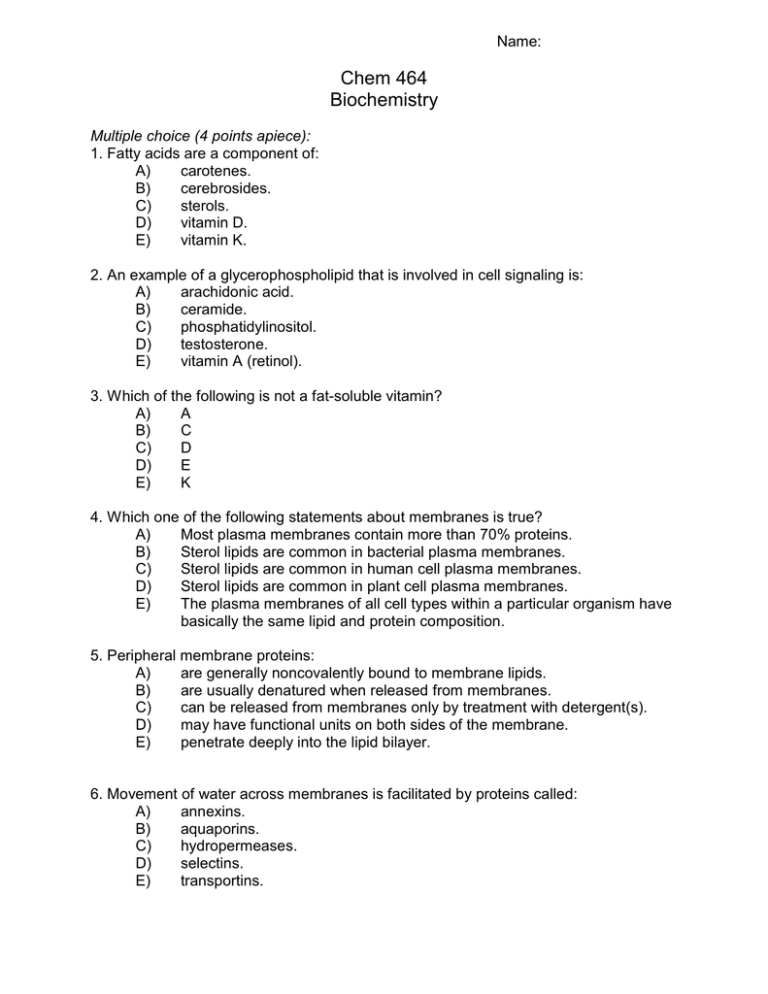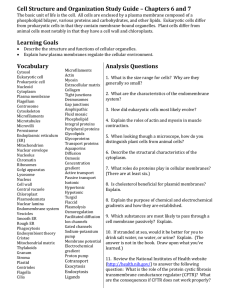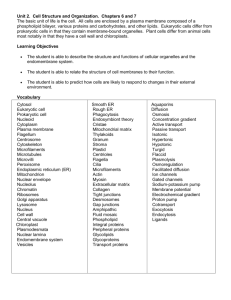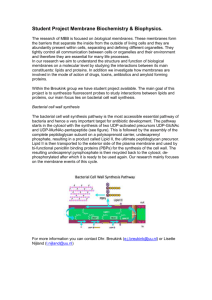Chem 464 Biochemistry
advertisement

Name: Chem 464 Biochemistry Multiple choice (4 points apiece): 1. Fatty acids are a component of: A) carotenes. B) cerebrosides. C) sterols. D) vitamin D. E) vitamin K. 2. An example of a glycerophospholipid that is involved in cell signaling is: A) arachidonic acid. B) ceramide. C) phosphatidylinositol. D) testosterone. E) vitamin A (retinol). 3. Which of the following is not a fat-soluble vitamin? A) A B) C C) D D) E E) K 4. Which one of the following statements about membranes is true? A) Most plasma membranes contain more than 70% proteins. B) Sterol lipids are common in bacterial plasma membranes. C) Sterol lipids are common in human cell plasma membranes. D) Sterol lipids are common in plant cell plasma membranes. E) The plasma membranes of all cell types within a particular organism have basically the same lipid and protein composition. 5. Peripheral membrane proteins: A) are generally noncovalently bound to membrane lipids. B) are usually denatured when released from membranes. C) can be released from membranes only by treatment with detergent(s). D) may have functional units on both sides of the membrane. E) penetrate deeply into the lipid bilayer. 6. Movement of water across membranes is facilitated by proteins called: A) annexins. B) aquaporins. C) hydropermeases. D) selectins. E) transportins. 7. When a mixture of 3-phosphoglycerate and 2-phosphoglycerate is incubated at 25 °C with phosphoglycerate mutase until equilibrium is reached, the final mixture contains six times as much 2-phosphoglycerate as 3-phosphoglycerate. Which one of the following statements is most nearly correct, when applied to the reaction as written? (R = 8.315 J/mol·K; T = 298 K) 3-Phosphoglycerate W 2-phosphoglycerate A) B) C) D) E) G'° is -4.44 kJ/mol. G'° is zero. G'°is +12.7 kJ/mol. G'°is incalculably large and positive. G'° cannot be calculated from the information given. Longer questions 8. (10 points) In preparing this test I found the following statement in your text: “Humans require but do not have the capacity to synthesize the omega-3 PUFA álinolenic acid (ALA; 18:3(Ä9,12,15)), in the standard convention, and must therefore obtain it in the diet. From ALA humans can synthesize two other omega-3 PUFAs ... eicosapentaenoic acid (EPA; 20:5(Ä5,8,11,14,17)) ... and docosahexaenoic acid (DHA; 22:6 (Ä4,7,10,13,16,19)).” What a bunch of biochemical gobble-de-gook. Please tell me what this things mean... Omega-3 PUFA ALA EPA DHA eicosapentaenoic acid docosahexaenoic acid And what is the structure of these fatty acids... 18:3(Ä9,12,15) 20:5(Ä5,8,11,14,17) 22:6 (Ä4,7,10,13,16,19) 9A. (5 points) Draw the structure of Sphingosine. B. (5 points) Tell me about the various types of sphingolipids 10. A.(5 points) When we discussed the structure of a cell membrane we started off with the simple fluid mosaic model for a membrane. Describe this model in 3 or 4 sentences. B. Later in this chapter we added more complications and details like.. (1 point) What is a lipid corral? (1 point) What is a membrane raft? (1 point) How can proteins change the curvature of a membrane? (2 points) How can proteins fuse membranes together? 11. (10 points) To transport glucose from the lumen of your gut to your blood, an intestinal epithelial cell uses an Na+ - glucose symporter, an Na+ K+ ATPase, and a glucose uniporter. Put these pieces together. What do each of these transport proteins do? Where are they located in the cell (on the lumen side or on the blood side of the cell)? Explain why you need all three transporters to make things work. 12. (10 points) In Chapter 12 you were asked to study any one of the six general types signal transduction systems on your own. Tell me about what you learned. 13. (10 points) The ÄGo’ for the hydrolysis of ATP (ATPWADP + Pi) is -30.5 kJ/mole. But that is for standard state conditions, we learned that the ÄG of a reaction changes with the actual concentrations of reactant and product found in the cell. What is the ÄGrxn for the hydrolysis of ATP in a human red blood cell where [ATP]=2.25 mM, [ADP]=0.25 mM, and [Pi]=1.65 mM? 14 A. (5 points) In the glycolytic pathway we will find the reaction Glucose 6-phosphate W Fructose 6-phosphate has a ÄGo’ of 1.7 kJ/mole. What is the Equilibrium constant (K) for this reaction? B. (5 points) In another step in the glycolytic pathway we will find the reaction Fructose 6-phosphate + ATP WFructose 1,6-bisphosphate has an overall ÄGo’ of -14.2 kJ/mol. You can think of this reaction at two linked reactions: Fructose 6-phosphate + Pi WFructose 1,6 bisphosphate -andATP W ADP + Pi If the reaction ATP W ADP + Pi has a ÄGo’ of -30.5 kJ/mol, what is ÄGo’ for the other reaction (Fructose 6-phosphate + Pi WFructose 1,6 bisphosphate) ? 1B 2C 3B 4C 5A 6B 7A






